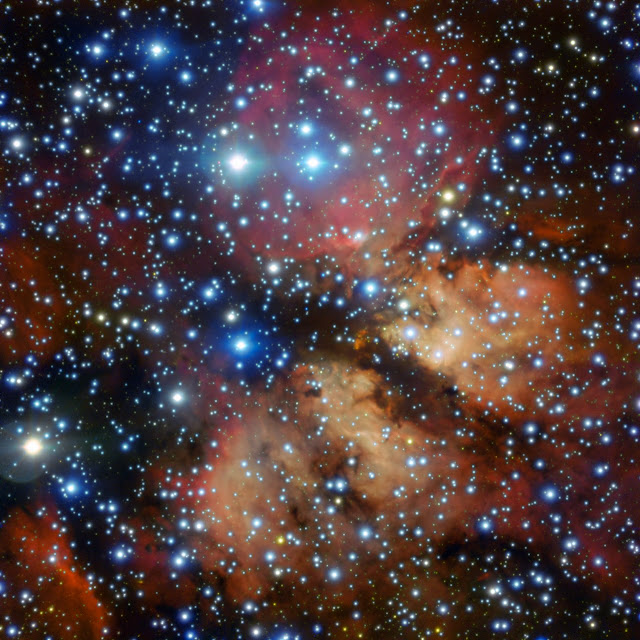Artist's impression of the cosmic cow
Credit: Shanghai Astronomical Observatory, China
Observations using 21 telescopes of the European VLBI Network (EVN) have revealed that a cosmic explosion, called AT2018cow most likely formed a neutron star with an extremely powerful magnetic field - known as a magnetar. The high-resolution radio images produced in this new study show physical properties of the stellar remnant that make alternative explanations less likely, say scientists.
Among short-lived sky phenomena, AT2018cow (The Cow) is an astronomical event like no other. First detected in 2018, it received its memorable name by chance according to alphabetical protocol to classify such events. However, it was not just its name that makes it memorable. AT2018cow was identified in a relatively nearby galaxy (about 200 million light years away). Its proximity, exceptionally brief brightness and unusually high temperature led to widespread attention upon discovery.
Originally discovered with optical telescopes, follow up observations were conducted across wavelengths from X-ray to radio. These observations indicated that there is a ‘central engine' which powered the event. This resulted in theories that the mysterious source could be a supernova - a star whose central core collapsed - or a Tidal Disruption Event (TDE), where a white dwarf star is being ripped apart as it approaches a massive black hole.
In the current study, an international team was led by Prashanth Mohan, astronomer at the Shanghai Astronomical Observatory, China.
"Both these theories suggested that the observed central engine would produce relativistic jets - a high energy expulsion of material. These jets, when aligned with our line of sight, would appear much brighter as ionised matter is accelerated close to the speed of light, and could be responsible for the exceptional brightness of the event. With a network of radio telescopes, we decided to test whether that was the case", explains Tao An.
The team monitored the radio afterglow to search for a relativistic jet from the Cow. They conducted five observations over the course of a year, using a total of 21 telescopes from the European VLBI Network (EVN). The high-resolution radio imaging provided by the EVN, led the team to a surprising conclusion: there was no sign of a relativistic jet.
"These most detailed images in the radio regime do not show any relativistic motion or expansion during this time period. That argues against a jet in the Cow, at least later in its evolution. Instead it seems that the Cow was intrinsically bright and originated from a star exploding as a supernova", says Jun Yang, astronomer at Onsala Space Observatory, Chalmers University of Technology in Sweden.
Further, the astronomers' observations reveal physical conditions that can only be explained by the presence of a neutron star with extremely strong magnetic fields (a magnetar), which was born in the explosion.
"We see signs that material from the explosion expanded into a dense, magnetized environment. The way the radio signals faded is just what we might expect if the Cow's "central engine" is a magnetar which formed from the collapse of a star's core" says Prashanth Mohan.
Such characteristics point to another intriguing possibility, the scientists suggest. Interaction of a magnetar with its strongly magnetized environment around it might also produce short enigmatic phenomena known as Fast Radio Bursts (FRBs).
"The EVN is the most sensitive standalone VLBI network in the world that has delivered cutting edge results in the field of transient science. It has by now provided the most accurate localizations of two FRBs. There is an intriguing possibility that there may be a link between FRBs and other type of transient sources (like the event that produced 2018ATcow), but this requires further studies", concludes Zsolt Paragi from the Joint Institute for VLBI ERIC (JIVE).
Publication link
Prashanth Mohan, Tao An, and Jun Yang. The Nearby Luminous Transient AT2018cow: A Magnetar Formed in a Subrelativistically Expanding Nonjetted Explosion. 2020, ApJL, 888, 24 https://iopscience.iop.org/article/10.3847/2041-8213/ab64d1
Contact
Assist. Prof. Prashanth Mohan - lead author
Shanghai Astronomical Observatory, China
Email: pmohan@shao.ac.cn
Prof. Tao An - author
Shanghai Astronomical Observatory, China
Email: antao@shao.ac.cn
Dr. Jun Yang - author
Onsala Space Observatory, Sweden
Email: jun.yang@chalmers.se
Zsolt Paragi - EVN contact
The Joint Institute for VLBI ERIC (JIVE), the Netherlands
Email: paragi@jive.eu
Phone: +31 521 596 536
Additional information
Observations were conducted with the European Very Long Baseline Interferometry Network (EVN). The EVN is the most sensitive Very Long Baseline Interferometry (VLBI) array in the world, which allows researchers to conduct unique, high-resolution, radio astronomical observations of cosmic radio sources. Data from the EVN is processed at the Joint Institute for VLBI ERIC (JIVE) - an international research infrastructure based in the Netherlands, which also provides support, conducts leading research and forwards technical development in the field of radio astronomy.
A total of 21 antennas from the EVN were involved in these observations: 300 m Arecibo, (USA), 32 m Badary (Russia), 32 m Cambridge (UK), 25 m Defford (UK), 100 m Effelsberg (Germany) 26 m Hartebeesthoek (South Africa), 32 m Irbene (Latvia), 16 m Irbene (Latvia), 76 m Lovell (UK), 40 m Kunming (China), 25 m Knockin (UK), 25 m Medicina (Italy), 25 m Onsala (Sweden), 64 m Sardinia (Italy), 32 m Svetloe (Russia), 65 m Tianma (China), 32 m Torun (Poland), 26 m Urumqi (China), 25 m Westerbork (Netherlands), 40 m Yebes (Spain), 32 m Zelenchukskaya (Russia).

























